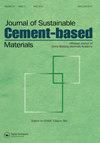Improvement in mechanical properties and microstructure of electric arc furnace slag bricks by microbial accelerated carbonation
IF 4.2
3区 工程技术
Q1 CONSTRUCTION & BUILDING TECHNOLOGY
Journal of Sustainable Cement-Based Materials
Pub Date : 2022-12-08
DOI:10.1080/21650373.2022.2153283
引用次数: 9
Abstract
In this paper, the promising way to utilize EAF (electric arc furnace) slag as a cementitious material has been studied by employing microbially accelerated carbonation technology. Under the conditions of cation supplementation and accelerated carbonation of bacteria, the highest compressive strength of the samples could achieve 18 MPa in this research. The changes in minerals and microstructures during the carbonation and microbial carbonation have been observed by X-ray diffraction (XRD), thermogravimetric analysis (TG), and mercury intrusion porosimetry (MIP). Carbonic anhydrase-producing microorganisms have obvious acceleration effects in the carbonation process, making the matrix compact and improving the mechanical properties. Besides, the treatment method of accelerating carbonation by microorganisms could effectively inhibit the leaching of heavy metals in the EAF slag. This paper provides a reference for the potential applications of EAF slag in engineering and reveals the mechanism of microbial acceleration. Highlights Industrial waste electric arc furnace (EAF) slag was used as a cementitious material and could fix carbon dioxide. Microbial technology promotes the deposition of calcium carbonate (1–5 μm) to fill pores over 1 μm. Microbial accelerated carbonated EAF bricks could reduce the leaching of heavy metals.微生物加速碳化对电弧炉渣砖力学性能和微观结构的改善
本文采用微生物加速碳化技术,对利用电弧炉炉渣作为胶凝材料进行了研究。在补充阳离子和加速细菌碳化的条件下,本研究样品的最高抗压强度可达到18 MPa。采用x射线衍射(XRD)、热重分析(TG)和压汞孔隙度测定(MIP)等方法观察了碳酸化和微生物碳酸化过程中矿物和微观结构的变化。产碳酸酐酶微生物在碳化过程中有明显的加速作用,使基体致密,提高了力学性能。此外,微生物加速碳化处理方法能有效抑制电炉渣中重金属的浸出。为电炉炉渣在工程上的潜在应用提供了参考,并揭示了微生物加速的机理。重点介绍了利用工业电弧炉废渣作为固定二氧化碳的胶凝材料。微生物技术促进碳酸钙(1 ~ 5 μm)沉积,填充1 μm以上的孔隙。微生物加速碳化电炉砖可以减少重金属的浸出。
本文章由计算机程序翻译,如有差异,请以英文原文为准。
求助全文
约1分钟内获得全文
求助全文
来源期刊
CiteScore
6.60
自引率
15.90%
发文量
71
期刊介绍:
The Journal of Sustainable Cement-Based Materials aims to publish theoretical and applied researches on materials, products and structures that incorporate cement. The journal is a forum for discussion of research on manufacture, hydration and performance of cement-based materials; novel experimental techniques; the latest analytical and modelling methods; the examination and the diagnosis of real cement and concrete structures; and the potential for improved cement-based materials. The journal welcomes original research papers, major reviews, rapid communications and selected conference papers. The Journal of Sustainable Cement-Based Materials covers a wide range of topics within its subject category, including but are not limited to: • raw materials and manufacture of cement • mixing, rheology and hydration • admixtures • structural characteristics and performance of cement-based materials • characterisation techniques and modeling • use of fibre in cement based-materials • degradation and repair of cement-based materials • novel testing techniques and applications • waste management

 求助内容:
求助内容: 应助结果提醒方式:
应助结果提醒方式:


